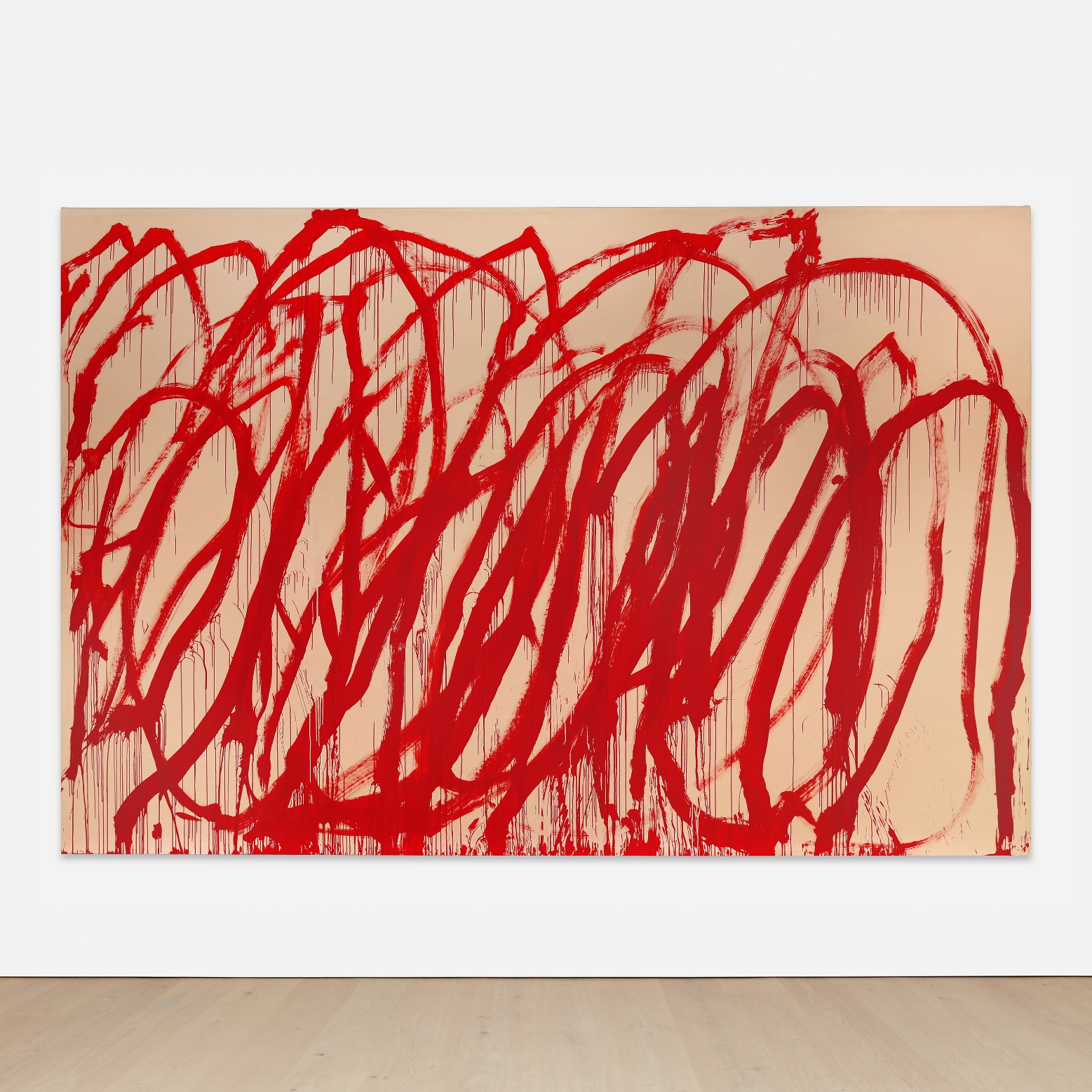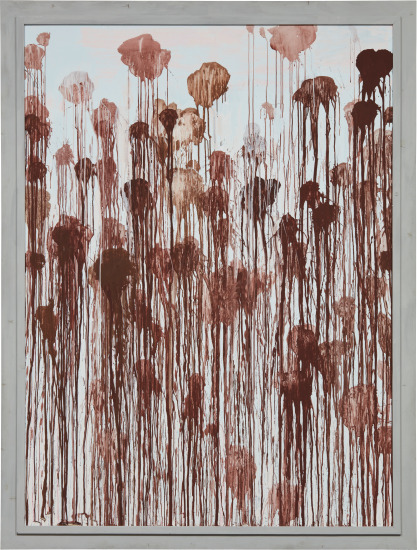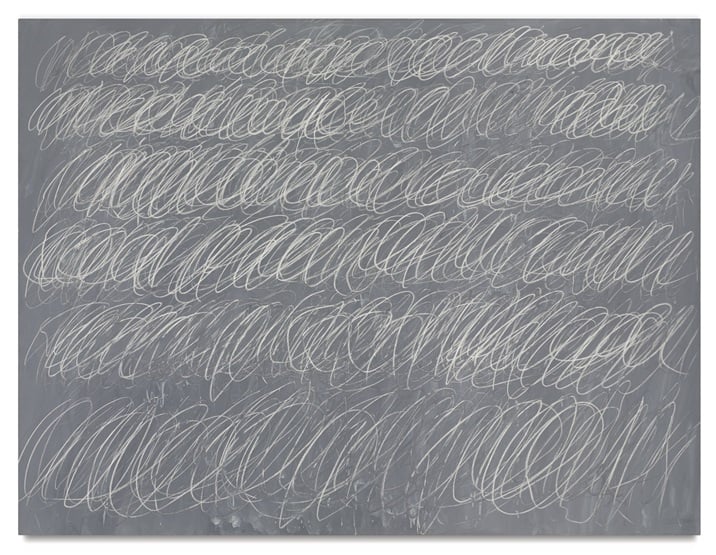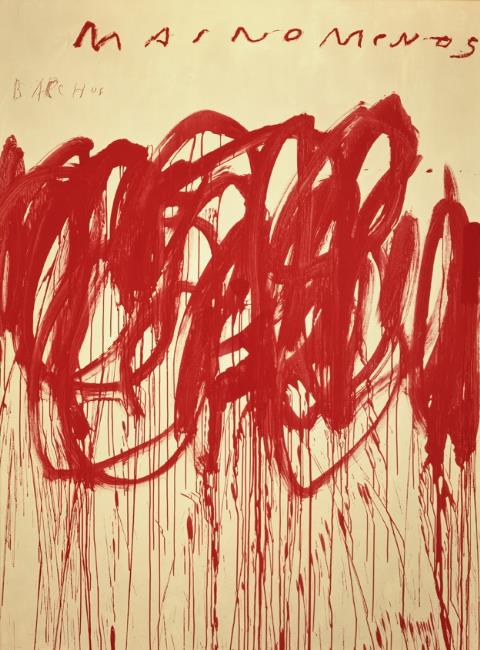
Cy Twombly
Untitled, 2005
Estimate: $35,000,000 – 45,000,000
On 15 November, Phillips’ Evening Sale of 20th Century & Contemporary Art in New York will be led by Cy Twombly’s monumental Untitled, 2005. With exceptional provenance and estimated at $35-45 million, Untitled is a masterpiece from one of Twombly’s last epic series that found its inception in his blackboards and crystallized in the three discrete suites of paintings collectively known as the Bacchus series. The Bacchus paintings began in 2003 amidst the US invasion of Iraq and culminated in 2008 when the artist donated three of the monumental works to the Tate Modern, London. The present work is the second-largest canvas from the 2005 series which were exhibited under the collective title Bacchus Psilax Mainomenos. Recalling the artist’s earlier Blackboard paintings from the late 1960s with its continuous looping forms, the Bacchus series revisits this earlier motif with a renewed vigor and energy which manifests on the surface of Untitled.
Jean-Paul Engelen, President, Americas, and Worldwide Co-Head of 20th Century & Contemporary Art, said, “With the top ten auction prices for works by Cy Twombly having all been set in the past eight years, it’s clear that the market is stronger than ever. At sixteen feet wide, Untitled is among the largest of Twombly’s works to ever appear at auction, with its subject referring to the dual nature of the ancient Greek and Roman god of wine, intoxication, and debauchery. The work hails from the series that marked Twombly’s ultimate artistic expression at the summit of his career and we are proud to offer this masterpiece as the highlight of our Fall season.”
The translation of Bacchus Psilax Mainomenos references both the exuberance and rage that alcohol can bring, with Tate Director Nicholas Serota remarking about the paintings, “They relate obviously to the god of wine and to abandon, and luxuriance, and freedom.” The work also recalls one of the most violent and emotionally stirring moments of Iliad, when the Greek hero, Achilles, kills the Trojan prince, Hector, dragging his corpse in circles through the desert around the walled city of Troy—just as Twombly’s red line colors the ground of Untitled.
The repetition of the mythical theme in Twombly’s work, particularly the continued invocation of Bacchus across the years, finds its stylistic parallel in Twombly’s signature, circular, scrawling gesture. Two extremes rise and fall within one ancient deity, cycling, one over the other, just as Twombly’s brush turns across the surface of Untitled. This gesture appeared in the artist’s earlier Blackboard series of the 1960s, making a reprise in Untitled, though with a much wilder red spiral. The red line of Untitled is rich with emotive movement as the spiral turns and drips across the canvas, the result of Twombly likely using his whole body, swinging the brush, which he attached to a long pole, across the canvas.

Executed in the final decade of Cy Twombly’s life, Untitled, 2004, pays homage to the Mediterranean sea of his adopted home in Italy. It is one of ten paintings that comprise the artist’s acclaimed Untitled (Winter Pictures) series, which the artist painted in the winter of 2003-2004 from his home in Gaeta. Building on Twombly’s epic series Quattro Stagioni (A Painting in Four Parts), 1993-1994, in the collection of Museum of Modern Art, New York, the series Untitled (Winter Pictures) points to Twombly’s preoccupation with the classical leitmotif of nature’s seasons. A remarkable example of Twombly’s inimitable painterly practice, Untitled is built up with coats of acrylic paint that the artist applied to the wooden panel with a combination of brush, cloth and hand. While works from this series typically feature similar cascading vertical lines, Untitled is one of only two painting distinguished by repeated circular blotches that run in splattering rivulets like dripping clouds beyond the edges of the pictorial suppor
Cy Twombly, Leda and the Swan, 1962, oil, lead pencil and wax crayon on canvas
Koji Inoue, International Director, Post-War and Contemporary Art, remarked:
“Hidden from public view for over 25 years, we are thrilled to present one of Cy Twombly’s absolute masterpieces in Leda and the Swan, 1962. This is a remarkable painting that has been pursued by collectors for decades. Impregnated with paint passionately and poetically applied with the hand, brush and stick, Leda and the Swan, is one of the most vital canvases created during this transformative period in the artist’s career. Given its tremendous importance within the context of both Twombly’s oeuvre, and the canon of Post-War art, we are honored to have the opportunity to offer this work to the market after nearly thirty clandestine years. This is also a particularly exciting time for the Twombly market, given its overlap with the Centre Pompidou’s groundbreaking retrospective of the artist’s expansive career.”
With its vigorous application of paint and affectionate use of the hand, Leda and the Swan is an apex example of the artist’s fusing of myth, eroticism and history. Revisiting the story of Leda’s seduction by the Greek god Zeus, or his Roman counterpart, Jupiter, in the form of a swan*, Twombly’s adaptation of this classical story inspired an increasingly baroque tendency that emerged in his work during the early 1960s, dramatically enriching the strongly tactile and sensual nature of his art. Throughout these paintings from the early 1960s, the artist not only arrives at, but fully executes some of the most empowering themes found throughout his oeuvre.
Leda and the Swan is part of a cycle of works that resulted from the explosive and highly physical release of passion, seduction and visceral energy that had defined Twombly’s Ferragosto paintings, which were executed throughout the hot summer months of 1961. Demonstrating this new, distinctly Baroque mix of eroticism and violence, Leda and the Swan exemplifies the “blood and foam” style that dominated the artist’s work until 1966.
The myth of “Leda and the Swan” is among dramatic and tumultuous themes in Twombly’s work of the early 1960s. A magnum opus of the artist’s oeuvre, Leda and the Swan fully articulates Twombly’s desire to defeat tradition even as he engaged with it. Immersing himself in ancient Greek and Roman literature, Twombly demonstrates the breadth of the artist’s cultural immersion in his Mediterranean surroundings.
The auction record for Cy Twombly was set by Untitled (New York City), oil based house paint and wax crayon on canvas, 1968, which realized $70,530,000 in November 2015.
On 11 May 2016 Sotheby’s New York will offer Untitled (New York City) by Cy Twombly in the Contemporary Art Evening Sale. The work is the only painting from the famed Blackboard series executed with blue loops on grey ground and boasts a remarkable history. It was acquired by the current owner from the artist’ s studio immediately after it 2 was executed in 1968, and has not been seen in public since. Untitled (New York City) is expected to fetch in excess of $40 million.
Untitled (New York City) is a one-off example of the artist’s most hallowed series of Blackboard paintings through which he forged a new visual language in a period of great convergence in postwar art. However, unlike every other Blackboard painting that bears white loops, in Untitled (New York City) Twombly used a blue, rather than white, wax crayon to create the endless ove rlapping loops on the wet paint. At over 28 square feet, the work belongs to the elite group of large-scale works by Twombly that can be found in the world's great museums including: The Museum of Contemporary Art, Los Angeles; The Menil Collection, Houston; and The Solomon R. Guggenheim Museum, New York.
The appearance of Untitled (New York City) at auction comes just six months after Sotheby’s set a record for the artist with Untitled [New YorkCity], 1968 from the collection of Los Angeles philanthropist Audrey Irmas. That work was the second Twombly Blackboard to exceed $65 million in the previous 18 months.
The sale will also include a major late Twombly: Untitled (Bacchus 1st Version V) . The appearance of the 2004 work in May marks the first time an example from the series, that is widely recognized as defining the artist’s late work, has appeared at auction. The painting is expected to fetch in excess of $20 million and will also be on view in Los Angeles alongside highlights by Franci s Bacon and Andy Warhol.
On May 10, Christie’s will feature
Clyfford Still’s PH-234, 1948 (estimate: $25-35m)
among the top lots of its New York Evening Sale of Post-War & Contemporary Art.
The majority of Still’s work resides in the collections of museums and institutions, including the Clyfford Still Museum in Denver, making the appearance of PH-234 a rare opportunity to acquire an extraordinary and iconic example of Still's work at the heights of his artistic power. In its’ nearly 60 years PH-234 has only had two previous owners and was included in an major Still retrospective curated by James Demetrion at The Hirshhorn Museum in 2001, Clyfford Still: Paintings, 1944-1960.
Laura Paulson, Chairman, Post-War and Contemporary Art, America’s, remarked: “Clyfford Still’s paintings are among the most powerful and important produced in latter part of the twentieth century, and we are honored to present PH-234 in one of the rare instances that an example of this magnitude comes onto the market from the artist. PH-234 is a consummate masterpiece by Still, which conveys the essence of his awe-inspiring oeuvre. Demonstrating Still’s distinctive style and technique, PH-234 quickly reveals the rich and almost limitless possibilities of color, surface and space. Originally acquired in 1957 by visionary English collector, Ted Power, who was one of the first English collectors to acquire major examples of the New York School and Pop Art, PH-234 is a commanding representation of the visceral potency of Abstract Expressionism at its zenith.”
Still’s reputation as one of the giants of Abstract Expressionism is built upon this mastery of the painterly process. Unique among his contemporaries, Still built up his richly textured surface by painting layer upon layer of richly pigmented oil paint carefully sculpting and applying each brush stroke. Still would often scrape away the surface only to rebuild it again, resulting in a surface both densely layered with color or often transcendent, conveying deep, mystical space. The spatial relationships created from this process and Still's vision, especially as seen in PH-234, result in a composition that is dynamic, almost topographical, and what ultimately defined Still's mastery of the canvas and set him apart from his colleagues such as Pollock, Newman and Rothko.
This painting was produced during the period immediately after Still's first great solo exhibition at Peggy Guggenheim's Art of this Century Gallery in February 1946. In the introduction to the exhibition Still's then friend, Mark Rothko, related Still's new art to the epic and transcendent dimension of "Myth" and explained how Still, "working out West, and alone," had, with "unprecedented forms and completely personal methods," arrived at a completely new way of painting. The simple, seemingly organic forms of Still's painting and its bold expansive fields of space and color made, "the rest of us look academic" Jackson Pollock observed at the time.
PH-234 was shown in Still’s first solo exhibition at the Betty Parsons Gallery in 1951, and acquired in 1957 by E.J. "Ted" Power, one of the great collectors of international postwar art. Beginning in the mid-1950s, Power sought out the newest and most radical art he could find. He taught himself to discern what moved him and refined his eye to search for quality works by artists such as Mark Rothko, Jackson Pollock and Barnett Newman. He acquired PH-234 in January 1957 after becoming enthralled with the work of the Abstract Expressionists at the important exhibition of new American art organized by the Tate Gallery in London.
Still’s work, and examples such as PH-234, in particular represent the pinnacle of Abstract Expressionism—a pure form of painting that relies solely on its creator to express the power and intense visceral nature of its form. His best works have an inherent power that is perhaps best summed up by Still himself, who in a rare moment of retrospection characterized the fundamental raison d’etre of his work when he concluded, "You can turn the lights out. The paintings will carry their own fire" (C. Still, quoted in M. Auping, Clyfford Still, exh. cat. Modern Art Museum of Fort Worth, 2002, p. 303). This painting carries this fire to its very core.
Top three lots for Clyfford Still at auction
1. 1949-A-No. 1, oil on canvas, 1949 | Sale of Sotheby's New York: Wednesday, November 9, 2011
Estimate: $25,000,000 - 35,000,000 | Price Realized: $61,682,500
2. 1947-Y-No. 2, oil on canvas, 1947 | Sale of Sotheby's New York: Wednesday, November 9, 2011
Estimate: 15,000,000 - 20,000,000 | Price Realized: $31,442,500
3. 1947-R-no. 1, oil on canvas, 1947 | Sale of Christie's New York: Wednesday, November 15, 2006
Estimate: $5,000,000 - 7,000,000 | Price Realized $21,296,000

